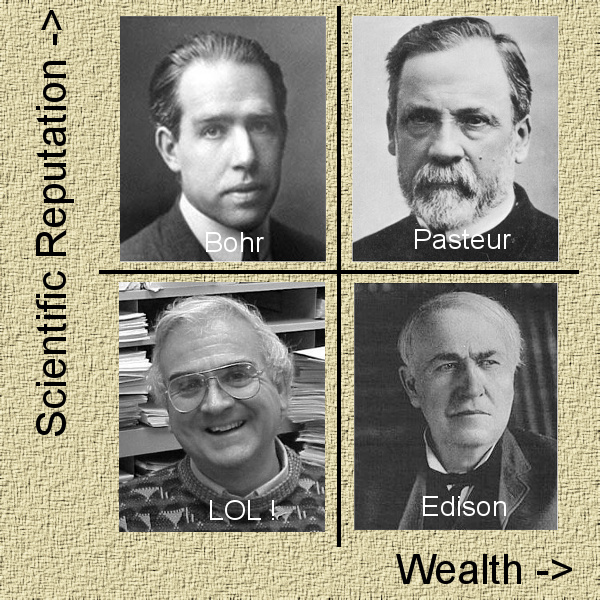| Tikalon Blog is now in archive mode.
An easily printed and saved version of this article, and a link
to a directory of all articles, can be found below: |
|
This article |
| Directory of all articles |
The Two-by-Two Matrix
September 1, 2010
No, this isn't a mathematics tutorial. It's about a graphical representation of ideas that's used in business circles. Many years ago, I bought the book,
"The Power of the 2 x 2 Matrix,"[1] by Alex Lowy and Phil Hood, for my son, a freshly minted
MBA graduate. The book gives many examples of how the two-by-two matrix, in which a concept is scored with respect to two variables, can focus your thoughts on a problem. The matrix was apparently introduced by Igor Ansoff in a 1957 article, "Strategies for Diversification," in the
Harvard Business Review.[2] Ansoff worked at the
RAND Corporation and
Lockheed. He was vice president of the Industrial Technology Division of Lockheed Electronics before he became a management consultant. Ansoff's archetypal matrix is known as the
Ansoff Product-Market Growth Matrix, and numerous example are revealed in a
Google image search. The matrix variables in the Ansoff case are markets and products, where each variable ranges from existing to new. The four quadrants of the Ansoff Product-Market Growth Matrix have these associations.
• (existing markets, existing products) = Generic growth
• (existing markets, new products) = Product development
• (new markets, existing products) = Market development
• (new markets, new products) = Diversification
The Ansoff matrix doesn't have any value judgments associated with it. It focuses your attention on what you should do in each quadrant. The Lowy and Hood book, however, is rife with two-by-two matrices that express value judgments. I was reminded of this book when I read a review of a book in a recent issue of Science.[3] The review used an illustration from the book, "Pasteur's Quadrant: Basic Science and Technological Innovation," by Donald E. Stokes. [4] The illustration was a two-by-two matrix of scientific reputation and wealth, a reworked version of which appears below.
Niels Bohr occupies the upper left quadrant (low wealth, high scientific reputation). The wealth judgment must be near-term wealth, since
"atomic" energy is now quite practical and economically important.
Thomas Edison occupies the lower right quadrant (high wealth, low scientific reputation). Edison's inventions were the bases of huge industries (electrical power, recorded sound and motion pictures), but most of his work was of the trial-and-error, educated-guess variety. More importantly, his work didn't generate scientific information that might be useful in other areas. The star of the matrix is
Louis Pasteur, an eminent scientist who founded
biotechnology (
Pasteurization,
immunization and
vaccination). Of course, Pasteur's quadrant (high wealth, high scientific reputation) is the best quadrant. The low wealth, low scientific reputation, quadrant should be avoided.

Edison image courtesy of the University of Texas Libraries, The University of Texas at Austin.
Edison invented the industrial research laboratory, but modern corporations had ambitions to place their industrial scientists into Pasteur's quadrant. In my experience of thirty years of industrial research, they're lucky to still be in Edison's quadrant. Management techniques that have emerged over just the last decade are causing a migration to the unmentionable quadrant. You merely need to look at the example of
Bell Laboratories. Many Bell Labs scientists inhabited the Pasteur quadrant, as the
Nobel Prize roster and such things as the
invention of the transistor, prove. Management eventually forced a migration to the Edison quadrant. Since corporate money managers have very
sharp pencils, there's no migration to the lower left quadrant; rather, the migration is out the door.
Pasteur was French, so it's only fitting that we close this article with a recent quotation from French President,
Nicolas Sarkozy, who was addressing the
International Conference on High Energy Physics (
Paris, 2010)
"Without basic research, there can be no applications... After all, electricity and the light bulb were not invented by incremental improvements to the candle." [5]
References:
- Alex Lowy and Phil Hood, "The Power of the 2 x 2 Matrix: Using 2x2 Thinking to Solve Business Problems and Make Better Decisions," Jossey-Bass (May 4, 2004), 352 pp.; for a table of contents and a preview, look here.
- I. Ansoff, "Strategies for Diversification," Harvard Business Review, vol. 35, no. 5 (Sep-Oct 1957), pp.113-124.
- Michael Stampfer, "Science Policy: Trapped in the Lower Left Quadrant?" Science, vol. 329. no. 5991 (July 30, 2010), pp. 514-515.
- Donald E. Stokes, "Pasteur's Quadrant: Basic Science and Technological Innovation," (Brookings Institution Press, June 1997), 180 pp.. Preview available on Preview on Google Books
- Lauren Schenkman, "Random Samples," Science, vol 329, no. 5992 (August 6, 2010), p. 613.
Permanent Link to this article
Linked Keywords: MBA; Harvard Business Review; RAND Corporation; Lockheed; Ansoff Product-Market Growth Matrix; Niels Bohr; "Atomic" energy; Thomas Edison; Louis Pasteur; Pasteurization; immunization; vaccination; Bell Laboratories; Nobel Prize; invention of the transistor; bottom-line; Nicolas Sarkozy; International Conference on High Energy Physics; Paris.